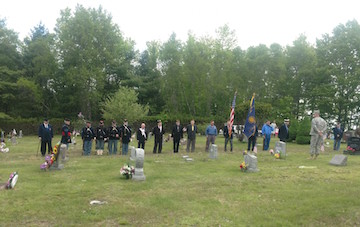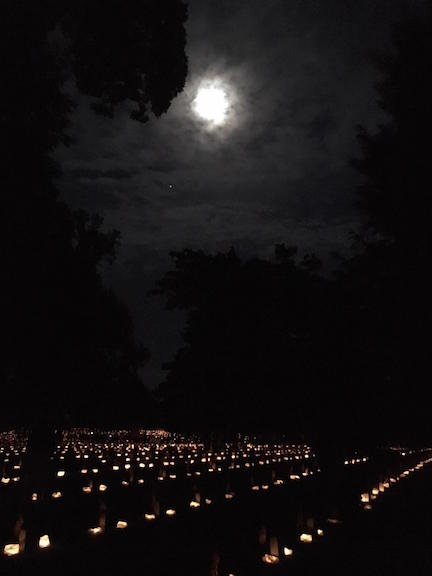Memorial Day in Rural Maine
 The trip up to Greenbush, Maine, along U.S. Route 2 parallels the east bank of the Penobscot River. The river in places gets to be half a mile or more from the road, and in other places, it’s right along the road, sometimes behind a thin screen of trees and sometimes wide open, quieter now than in the old logging days. This part of the Penobscot Valley is far enough north from Bangor that it might still be an earlier era if not for the pavement and the trucks.
The trip up to Greenbush, Maine, along U.S. Route 2 parallels the east bank of the Penobscot River. The river in places gets to be half a mile or more from the road, and in other places, it’s right along the road, sometimes behind a thin screen of trees and sometimes wide open, quieter now than in the old logging days. This part of the Penobscot Valley is far enough north from Bangor that it might still be an earlier era if not for the pavement and the trucks.
Every Memorial Day, my father hops into his pickup and drives this stretch northward from his home just north of Old Town. In my youth, we used to make this trip often in the early summer to get hay from the old Tinkham Farm. In Greenbush, he turns off and, past the Helen Dunn elementary/middle school, he follows the East Ridge Road to the intersection with the Gould’s Ridge Road, and from there travels north for a couple more miles, crossing into the town of Passadumkeag. On the right hand side of the road, carved out of the Maine woods, the Gould’s Ridge Cemetery—and its two Civil War veterans—waits for visitors.
Its formal name is the Sunny Slope Cemetery, which describes the property in pragmatic Yankee succinctness: a patch of sunny open space that slopes up modestly from the road. A pair of elongated horseshoe driveways provide access to the 200 or so graves, many of them old, old, old. Trees border the cemetery on three sides, but these are not the thick, dark Maine woods that grow not too far away. These have been moderately tamed by the homesteaders and farmers who’ve lived in this area since the early 1800s. The Penobscot tribe has lived in the area even longer.
A thousand such cemeteries dot the Maine back roads, or so it seems. The woods just open up for a small roadside collection of graves—sometimes there’s a church but more often not—and in a second we’ve whizzed by and the forest is once again there, and the cemetery, like its inhabitants, is just a memory—maybe even a “Did I just see that?” dream.
This is my father’s Memorial Day ritual: he comes each year to pay his respects. “It’s not much,” he tells me. “I do it as a way to connect to my dad [a WWII veteran] and to all my buddies who went off to Vietnam.”
But isn’t that the point: the take time on Memorial Day to pay your respects to those who’ve fallen in the service of the country?
 My father is one of a handful of people to turn out at this little Maine cemetery each Memorial Day. “Just some of the locals,” he tells me. A color guard lines up, joined by a few dignitaries and five reenactors from a unit with the 20th Maine who resemble aging Civil War veterans who’ve put on their uniforms for their own past Memorial Day commemorations.
My father is one of a handful of people to turn out at this little Maine cemetery each Memorial Day. “Just some of the locals,” he tells me. A color guard lines up, joined by a few dignitaries and five reenactors from a unit with the 20th Maine who resemble aging Civil War veterans who’ve put on their uniforms for their own past Memorial Day commemorations.
Veterans from several wars rest in Sunny Slope, including two Civil War vets. My dad asks Wayne Nickerson, the caretaker who looks after the veterans in the cemetery, who tells him the men’s names were Cary and Morrill. “Old names around here,” my dad tells me. A quick internet search even shows a Cary/Morrill reunion held in the area of Gould’s Ridge in the early 2000s.
I call Wayne. His hearing aid troubles him over the phone, so our conversation is slow and deliberate. He speaks in a Maine accent that reminds me of my childhood summers—or, “summahs,” as we would’ve said. Wayne has little to go on beyond the names of the two soldiers: Pvt. Calvin Nelson Cary, Co. E, 6th Maine, and Pvt. George W. Morrill, Co. F, 14th Maine. The town history suggests they might have been brothers-in-law, although Wayne says he has reason to believe the writer of the town history might have mixed up one Cary for another who also served.
Private Cary would have found himself in my neck of the woods during the war. Most notably, the 6th Maine stormed the stone wall and sunken road and took Marye’s Heights during the battle of second Fredericksburg. The 6th would later participate in similar spearhead attacks at Rappahannock Station and during Upton’s charge at Spotsy.
The 14th Maine, meanwhile, found itself in Louisiana for much of the war. Originally part of Ben Butler’s New Orleans Expeditionary Force, they later participated in the battle of Baton Rouge and the siege of Port Hudson. As a member of Co. F, Pvt. George Morrill would have also participated in a July 23-25, 1862, expedition to the Amite River. Herman Melville wrote a poem about the regiment, “On the Men of Maine killed in the Victory of Baton Rouge, Louisiana.”
Was Morrill one of those men Melville wrote about? If not, when and how did he die? An online list of the company’s final record that shows personnel changes from Nov. ’63 onward doesn’t list him, suggesting he died prior to that date. In July of 1864, the 14th Maine transferred to Bermuda Hundred in July of 1864, and then later took part in the Sheridan’s Valley campaign that fall, but I think Morrill had already returned to Passadumkeag by then. The corpse of a Union private killed in the summer Louisiana heat would pose a logistical challenge getting it back to the Penobscot Valley, so perhaps Morrill had only been wounded?
And what about Cary? What happened to him? How did he make it to the sunny slope in Passadumkeag?
As often happens, I now have more questions than answers. Now I have a new pair of Civil War stories to dig into. If Memorial Day is about paying our respects, then this will be my way to do so.
Just as my father has his own ritual for the holiday, so do I. I once again assisted with the annual luminary at Fredericksburg National Cemetery. It was, as always, a wonderful event, even with the threat of thunderstorms. But it looks like this year’s Memorial Day will also bring me like my father, to Gould’s Ridge in Passadumkeag, Maine—if not literally, then at least through the stories of the two veterans who rest there.

A nice meaningful story. And a great picture of the luminary! I too spend each year at the Memorial tribute at Fredericksburg. Thanks Chris. Andy
Thanks, Andy. Your work behind the desk at FVC to keep the visitor center open during the event is key, so thanks for your contribution. I’m always glad to see you there, my friend!
Thanks for this wonderful read! My late father in law ( also buried at sunny lope) and my husband know your father. They share the love of a good trap line! My Father Joseph Glen Grover has also found his resting place on sunny slope and my 92 year old Mother joined him there in Nov of 2016. He died in 1973. He served in World War 2 in the Navy. I believe he was a torpedo man on the USS Ludlow. I was only 9 when he died at the age of 51 of a heart attack. He was a great man and father. I am proud of his service to out great nation.
Thanks for sharing your father’s story, Sheila. I am glad that he and your mother get the attention they deserve on Memorial Day. To hear my dad tell it, it’s a great little ceremony with a very personal, meaningful touch. I’ll tell him I heard from you!
As a born and bred Mainiac I thank you for this story. I spent about 40 years less than 20 miles from this cemetery and attended funerals there. Recently we have relocated to Virginia.
My pleasure, Ruth. I used to live in Milford, went to high school in Old Town, worked in Ellsworth, and did my master’s at U-Maine. My daughter was born at EMMC. And of course my dad’s been there for 45 years. I’ve deep roots there!